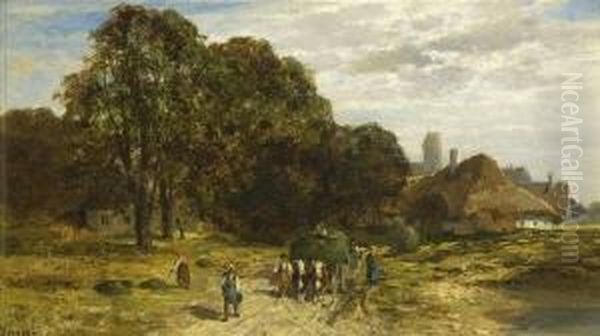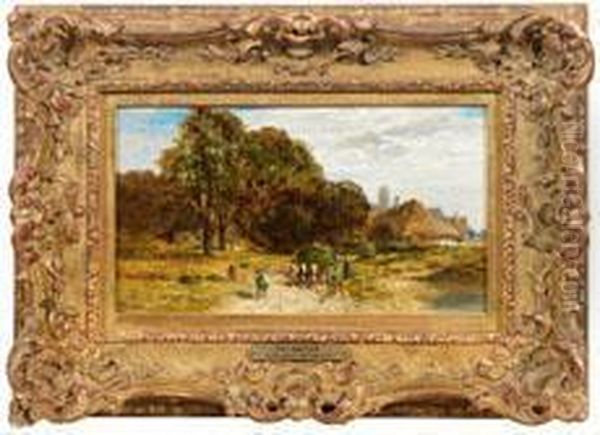Karl Adam Heinisch stands as a notable figure among German artists of the late nineteenth and early twentieth centuries. Born in 1847 and passing away in 1923, his life spanned a period of significant artistic evolution in Europe. Primarily recognized as a landscape painter, Heinisch dedicated his career to capturing the nuances of the natural world and rural life, leaving behind a body of work appreciated for its detail, atmospheric quality, and connection to the German artistic traditions of his time.
Origins and Background
Karl Adam Heinisch was born in 1847 in Neustadt, located in Upper Silesia (Oberschlesien), a region that is now part of Poland (Prudnik). Born into a German Protestant family, his upbringing occurred during a time of burgeoning industrialization and shifting cultural landscapes across Germany. While specific details about his formal artistic training or mentors remain elusive in readily available records, his work clearly demonstrates a skilled hand and a deep engagement with the prevailing artistic currents, particularly those centered around landscape painting.
His professional life unfolded primarily within the German-speaking world, and he eventually settled in Munich, a major European art center during his lifetime. Munich, with its prestigious Academy of Fine Arts and vibrant community of artists, provided a stimulating environment. Heinisch passed away in this Bavarian capital in 1923, concluding a long career dedicated to his craft.
Artistic Style and Thematic Focus
Heinisch's artistic output is dominated by landscape painting. His works often depict serene natural settings, tranquil riverbanks, expansive fields, and the quiet charm of village outskirts. He possessed a keen eye for detail, meticulously rendering foliage, water surfaces, and architectural elements within his compositions. His approach often aligns with the broader tendencies of Realism that characterized much of European art in the latter half of the 19th century, yet elements suggestive of the lingering influence of German Romanticism can also be discerned in the atmospheric sensitivity of his scenes.

A key characteristic of Heinisch's style is his attention to light and atmosphere. He skillfully captured the effects of sunlight filtering through trees, reflecting off water, or illuminating a pastoral scene. This focus suggests an artist deeply observant of the natural world and committed to translating its ephemeral qualities onto canvas. His palette often employed naturalistic tones, reinforcing the sense of fidelity to the observed environment.
While landscapes formed the core of his oeuvre, Heinisch also explored related themes. Scenes of rural life, featuring figures engaged in everyday activities like farming or washing clothes by a river, appear in his work. These paintings offer glimpses into the agrarian rhythms that still defined much of the German countryside during his era. Occasionally, he also turned his attention to subjects of contemporary or historical interest, demonstrating a versatility beyond pure landscape.
Representative Works
Several specific works help illustrate Karl Adam Heinisch's artistic contributions and thematic interests. These paintings, often appearing in auction catalogues and collection records, provide concrete examples of his style and subject matter.
One notable example is Lakeshore with Punt and Washerwoman (also known by the German title Sehen mit Kahn und Wascherin). Dated to 1889 and measuring approximately 23.5 x 27.5 cm, this oil painting captures a tranquil lakeside scene. The inclusion of figures – a person in a punt and a washerwoman by the shore – adds a narrative element to the landscape, grounding the natural setting in human activity. Records suggest this work was handled by the prominent Goupil's Gallery in New York and has also appeared in auctions, for instance, in Zurich.
Another significant piece is Zeppelin über München (Zeppelin over Munich), also referred to as Erste Zeppelinfahrt über München (First Zeppelin Flight over Munich). This work holds particular historical interest as it documents the dawn of aviation. While sources vary slightly on the exact date (citing 1907 or 1909) and dimensions (around 20 x 32.5 cm or 32 x 20.5 cm), the painting depicts the remarkable sight of an early Zeppelin airship floating above the Munich skyline. The event itself, likely the flight of LZ 6 in 1909, marked a technological marvel. Heinisch's painting captures this moment, blending landscape/cityscape with a record of historical progress. This work has appeared at auction, notably through ZISSKA & LACHER, sometimes listed with Viennese connections.

Vor dem Dorf (Before the Village), dated 1886 and measuring 48.5 x 77 cm, showcases Heinisch's engagement with rural scenery. This oil painting likely depicts the outskirts of a village, perhaps featuring fields, paths, or farm buildings leading towards the settlement. Its appearance in Munich auction records highlights the continued market interest in his traditional landscape themes. Some documentation links this work, perhaps through catalogue records, to resources associated with the Herzog August Bibliothek in Wolfenbüttel.
Heuernte (Hay Harvest) is another work centered on rural life. Sources present a discrepancy in dating, listing it as either 1886 or 1896. Measuring 73 x 53 cm, this oil painting depicts the agricultural activity of haymaking, a common theme for artists wishing to portray pastoral labor and the cycle of the seasons. Its connection to Munich, possibly through collections or auctions, is noted in records.
Additionally, a work titled HIRTEN MIT RINDERN AN DER TRÄNKE (Shepherds with Cattle at the Watering Place) further exemplifies his interest in pastoral subjects. This painting appeared in a Munich auction in 2012, indicating the enduring appeal of his depictions of traditional rural life and animal painting within a landscape context. These examples collectively demonstrate Heinisch's commitment to landscape and genre scenes, rendered with careful observation and atmospheric sensitivity.
Contemporaries and Artistic Context
Karl Adam Heinisch worked during a vibrant and diverse period in German art history. The latter decades of the 19th century and the early years of the 20th saw the continuation of academic traditions alongside the rise of new movements like Impressionism and, later, Expressionism. Munich, where Heinisch spent significant time, was a crucible of artistic activity.
He shared the artistic stage with numerous other painters. Among his contemporaries were figures associated with various schools and styles. Joseph Wenglein (1845-1919), an almost exact contemporary, was also known for his evocative Bavarian landscapes, often associated with the Munich School. Otto Strützel (1855-1930) was another prominent Munich landscape and animal painter.
The influence of Realism was strong, represented by artists like Wilhelm Leibl (1844-1900), whose circle in Munich emphasized direct observation and unidealized depictions. Although perhaps more focused on figure painting, the realist ethos impacted landscape art as well. Fritz von Uhde (1848-1911), active in Munich, bridged Realism and Impressionism, often incorporating religious themes into contemporary settings.
German Impressionism also emerged during Heinisch's career, with leading figures like Max Liebermann (1847-1935), born the same year as Heinisch, Lovis Corinth (1858-1925), and Max Slevogt (1868-1932) adapting French Impressionist techniques to German subjects, often with a darker palette and more vigorous brushwork. While Heinisch's style appears more rooted in detailed realism, he would certainly have been aware of these developments.
Other notable contemporaries included Adolf Hölzel (1853-1934), an influential painter and teacher associated with the Dachau artists' colony and later Stuttgart, known for his move towards abstraction. From the Düsseldorf School, Heinrich Hermanns (1862-1942) was known for his landscapes and cityscapes. International contemporaries whose careers overlapped include the Danish painters Axel Helsted (1847-1907) and Erik Henningsen (1855-1930), and the Dutch painter Gerke Henkes (1844-1927).
Towards the end of Heinisch's life, German Expressionism was taking hold, with artists like Erich Heckel (1883-1970) and others from the Die Brücke group forging a radically new path. While stylistically distant, these movements formed part of the evolving artistic landscape Heinisch inhabited. Other German painters active during parts of his career include Franz von Defregger (1835-1921), known for his historical and genre scenes, and Bernhard Hergenhan (1881-1975), representing a slightly younger generation. Heinisch navigated this complex scene, maintaining his focus on detailed, atmospheric landscape painting.
Auction Records and Collections
Karl Adam Heinisch's works continue to appear on the art market, primarily through auction houses in Europe. Records indicate sales in Germany (particularly Munich), Austria (Vienna), and Switzerland (Zurich). Auction houses like ZISSKA & LACHER and others featuring German art have handled his paintings. Estimates and sale prices, often in the range of several hundred to a few thousand Euros, reflect a steady appreciation for his competent and characteristic landscapes, especially those with historical interest like the Zeppelin painting or well-executed pastoral scenes.
In terms of public collections, specific information is somewhat limited, but Heinisch's work is represented in the Frye Art Museum in Seattle, Washington. This museum has significant holdings of German art from the period, particularly associated with the Munich School. The historical connection to Goupil's Gallery in New York suggests his work achieved a degree of international recognition during his lifetime. As mentioned earlier, documentation related to his work Vor dem Dorf has surfaced in connection with the Herzog August Bibliothek in Wolfenbüttel, though this might pertain to library records or auction provenance rather than the library holding the painting itself. The presence of his works in various auctions indicates they are also held in numerous private collections across Europe and potentially North America.
Unlike some of his more famous contemporaries, Karl Adam Heinisch does not seem to be associated with any widely known personal anecdotes, controversies, or a distinct school of followers. Information regarding specific students he may have taught is also lacking. His legacy rests primarily on the quality and consistency of his artistic output – the paintings themselves.
Conclusion
Karl Adam Heinisch was a dedicated German artist who devoted his long career primarily to landscape painting. Working within the traditions of Realism and late Romanticism prevalent in the Munich art scene, he created detailed and atmospheric depictions of the German countryside, rural life, and occasionally, moments of historical significance. Born in Silesia in 1847 and dying in Munich in 1923, he witnessed dramatic changes in the art world but remained largely committed to his representational style. His works, found in collections like the Frye Art Museum and circulating on the European art market, serve as enduring visual records of the landscapes and sensibilities of his time. Heinisch stands as a competent and sensitive chronicler of the natural world, contributing his distinct voice to the rich tapestry of German art in the late 19th and early 20th centuries.